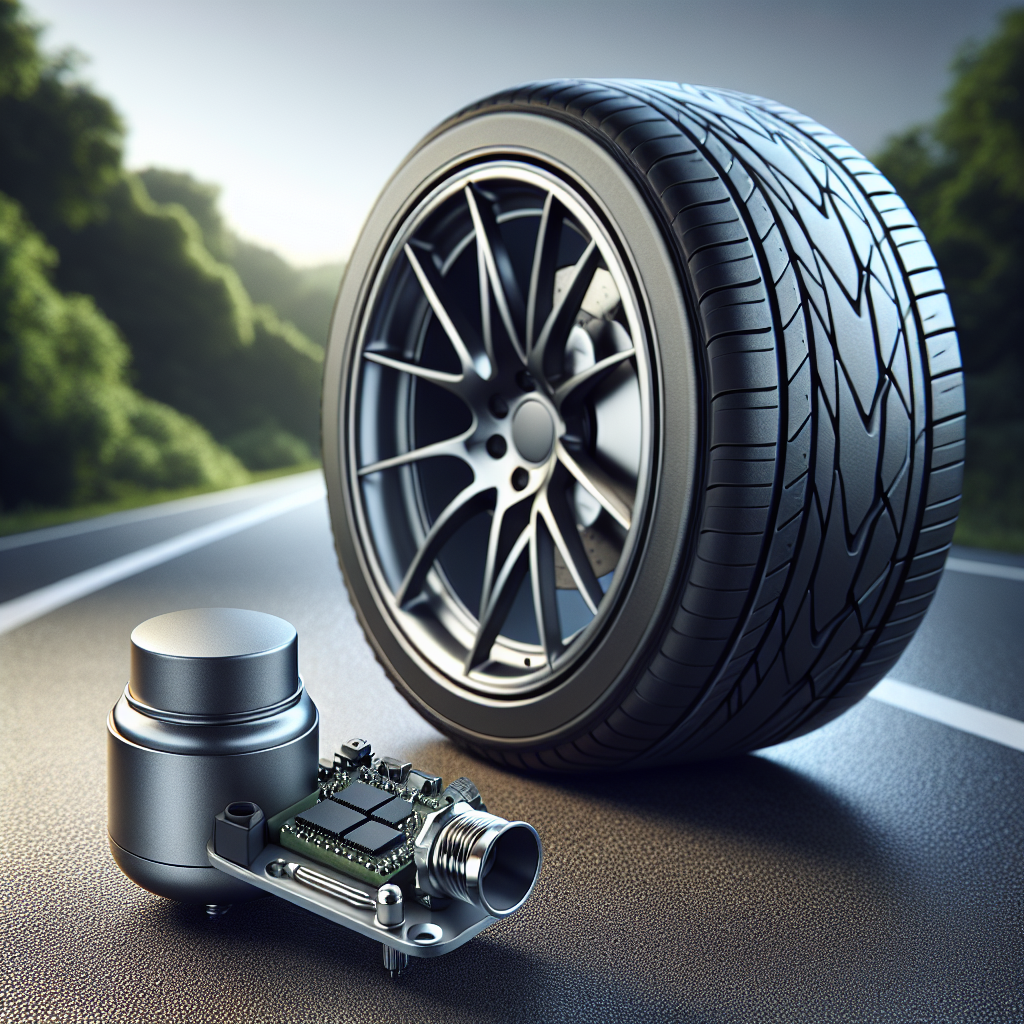In today’s fast-paced world, ensuring the safety of your vehicle is paramount. A Tyre Pressure Monitoring System (TPMS) plays a crucial role in achieving this goal. At its core, a TPMS is designed to monitor the air pressure inside your tires and provide real-time feedback to the driver. This technology alerts you to any significant drops in tire pressure, which can lead to hazardous driving conditions.
Understanding how tyre pressure monitors work is essential for both safety and efficiency. By utilizing sensors placed within the tire, the TPMS continuously checks for pressure fluctuations. If a tire’s pressure falls below the recommended level, the system triggers a warning light on your dashboard, prompting immediate attention. This proactive approach not only enhances safety but also contributes to better fuel efficiency and reduced tire wear.
Moreover, the integration of modern technology allows for enhanced features such as temperature monitoring, which further aids in preventing tire blowouts and accidents on the road. For trailer owners, a TPMS can be particularly invaluable, ensuring that your trailer remains in optimal condition during journeys.
So, whether you're hauling equipment or transporting goods, it's vital to stay informed about your trailer's tire health. Tow with peace of mind, knowing that trailerwatchdog is standing guard.
Understanding How Tyre Pressure Monitors Work
To fully appreciate the advantages of a Tyre Pressure Monitoring System (TPMS), it is essential to understand its inner workings. At its core, a TPMS consists of sensors that are mounted on the valve stems of each tire. These sensors continuously measure the tire's air pressure and temperature, transmitting this data to a central control unit.
There are primarily two types of TPMS: direct and indirect systems.
- Direct TPMS: This system uses pressure sensors located inside the tires. These sensors provide real-time data on tire pressure and temperature directly to the vehicle’s onboard computer. If the pressure drops below a predefined threshold, the system activates a warning light on the dashboard.
- Indirect TPMS: In contrast, this system does not rely on physical sensors. Instead, it uses the vehicle's ABS (Anti-lock Braking System) sensors to monitor the rotational speed of the tires. If a tire is under-inflated, it will rotate faster than properly inflated tires, triggering a warning light.
Both systems have their advantages, but direct TPMS is generally more accurate and provides more detailed information. Additionally, many modern TPMS units are equipped with features such as automatic recalibration and data logging, which help in maintaining optimal tire performance.
Understanding how tyre pressure monitors work is vital for any vehicle owner. By being aware of the pressure levels in your tires, you can ensure safer driving conditions and enhance the longevity of your tires.
Importance of Proper Tyre Pressure for Safety

Maintaining proper tyre pressure is not just a matter of vehicle performance; it is a crucial aspect of road safety. Properly inflated tires contribute significantly to vehicle handling, braking efficiency, and overall stability. When tires are inflated to the manufacturer’s recommended pressure, they provide optimal traction and grip on the road, reducing the risk of slip or skid.
Conversely, driving on under-inflated tires can lead to several dangerous situations:
- Increased Risk of Blowouts: Low pressure increases tire flexing, generating excessive heat. This can lead to tire blowouts, which can result in loss of control and catastrophic accidents.
- Poor Fuel Efficiency: Under-inflated tires create more rolling resistance, requiring the engine to work harder, thus consuming more fuel. This not only costs you more at the pump but also increases emissions.
- Uneven Tire Wear: Improperly inflated tires wear unevenly, leading to a shorter lifespan. This not only necessitates more frequent replacements but can also compromise safety.
- Longer Stopping Distances: Tires that are not properly inflated can increase stopping distance, making it harder to react in emergencies.
Moreover, over-inflation is equally hazardous, as it can lead to a harsh ride and reduced contact with the road, negatively affecting traction. Regularly checking and maintaining your tire pressure is essential for ensuring not just your safety but that of other road users as well.
Features of Advanced Tyre Pressure Monitors

Advanced tyre pressure monitors (TPMs) have revolutionized vehicle safety and maintenance by providing real-time data and alerts to drivers. These sophisticated systems are designed to enhance safety, efficiency, and convenience on the road. Here are some of the key features that make advanced tyre pressure monitors indispensable:
- Real-Time Monitoring: Modern TPMs continuously monitor tyre pressure and temperature, providing instant feedback to the driver. This ensures that any deviations from the optimal pressure range are detected quickly, allowing for immediate corrective action.
- Alerts and Notifications: When tyre pressure falls below or rises above the recommended levels, the system sends alerts, often through visual or audible signals. This feature helps prevent accidents by informing drivers before a serious issue develops.
- Data Logging: Many advanced systems log historical data on tyre performance, enabling users to track trends over time. This information can be invaluable for maintaining optimal tyre health and planning maintenance schedules.
- Wireless Connectivity: Advanced TPMs often feature wireless technology, allowing for easy installation and integration with mobile applications. Drivers can monitor tyre conditions from their smartphones, enhancing convenience and accessibility.
- Temperature Monitoring: Besides pressure, these monitors also track tyre temperature. This is crucial, as elevated temperatures can indicate potential problems such as under-inflation or overloading, alerting the driver to take preventive measures.
- Multi-Tyre Monitoring: For larger vehicles or trailers, advanced TPMs can monitor multiple tyres simultaneously, providing a comprehensive overview of tyre health across the vehicle.
By utilizing these advanced features, drivers can significantly enhance their safety and that of their passengers. The investment in a reliable tyre pressure monitoring system pays off by preventing accidents and reducing maintenance costs in the long run.
Benefits of Using Tyre Pressure Monitoring Systems

The integration of tyre pressure monitoring systems (TPMS) into vehicles offers a myriad of benefits that extend beyond mere convenience. These systems significantly contribute to vehicle safety, performance, and efficiency. Here are some of the key advantages of using tyre pressure monitoring systems:
- Enhanced Safety: One of the primary benefits of TPMS is its ability to alert drivers about under-inflated or over-inflated tyres, which are major contributors to accidents. By maintaining optimal tyre pressure, the risk of blowouts and loss of vehicle control is substantially reduced.
- Improved Fuel Efficiency: Properly inflated tyres contribute to better fuel economy. Studies have shown that maintaining tyre pressure within recommended limits can improve fuel efficiency by up to 3%. This not only saves money at the pump but also reduces carbon emissions.
- Extended Tyre Life: Consistent monitoring of tyre pressure helps to minimize uneven wear and tear. By ensuring that tyres are neither under-inflated nor over-inflated, TPMS can help extend the lifespan of tyres, leading to fewer replacements and lower overall costs.
- Convenience: Many modern TPMS offer features such as real-time data transmission to mobile apps, allowing drivers to monitor tyre conditions easily. This convenience helps drivers stay informed without the need for manual checks.
- Increased Performance: Proper tyre pressure is crucial for optimal vehicle performance. A well-maintained tyre ensures better traction, handling, and braking, enhancing overall driving experience.
- Environmental Benefits: By improving fuel efficiency and extending the life of tyres, TPMS contributes to reduced waste and lower emissions, promoting a more environmentally friendly approach to driving.
Incorporating a tyre pressure monitoring system into your vehicle is not just an investment in technology; it’s an investment in safety, efficiency, and cost savings.
Conclusion and Future of Tyre Safety Technology

As we delve into the future of tyre safety technology, it becomes increasingly clear that advancements in monitoring systems will play a pivotal role in enhancing road safety. The integration of tyre pressure monitoring systems (TPMS) has already transformed how we approach vehicle maintenance, providing invaluable insights into tyre health and performance. With ongoing innovation, we can expect even more sophisticated systems that will incorporate additional sensors and data analytics to monitor not just tyre pressure but also temperature, tread depth, and overall tyre condition.
Emerging technologies such as artificial intelligence and machine learning will likely enhance the predictive capabilities of these systems, allowing for proactive maintenance alerts and real-time recommendations tailored to individual driving habits. As vehicles become smarter and more connected, the potential for integrating tyre safety technology with other vehicle systems presents exciting possibilities. Imagine a future where your vehicle automatically adjusts tyre pressure based on load or road conditions, optimizing performance and safety.
Furthermore, the push towards electric and autonomous vehicles will necessitate even more advanced tyre safety solutions to meet the unique demands of these technologies. The emphasis on sustainability and efficiency will continue to drive innovation in the tyre safety industry.
Ultimately, the evolution of tyre safety technology will not only enhance the driving experience but also contribute to a safer, greener future on the roads. Tow with peace of mind, knowing that trailerwatchdog is standing guard.








